
Pairing Leucanthemums
Our 5 ideas to enhance the daisy!
Contents
Leucanthemums, more commonly known as “great daisy”, are timeless perennials that brighten up summer with their flowering! Today, there are many new cultivars of leucanthemum with flowers as diverse as each other. From the classic single white daisy to the more sophisticated large daisy with shaggy petals, leucanthemum retains all its rustic charm. These plants easily integrate into naturalistic borders, as well as mixed borders in cottage gardens. White daisies are perfect in a white garden or in a romantic setting. Some, smaller varieties, are suitable for pot planting. Discover our inspirations for pairing your white or yellow leucanthemums without delay!
⇒ Visit our page Daisy, Leucanthemum: plant and maintain to learn everything about this perennial.
In a cottage garden
With its tall silhouette, leucanthemum easily fits into an English cottage garden alongside easy-to-grow summer-flowering perennials. At the back of the border, the tallest plants should be installed first. In this type of garden with lush vegetation, certain perennials are essential: hollyhocks, foxgloves, and larkspur. They will add height and verticality to this flowering border. Then, at their feet, you will place your leucanthemum. Choose a variety of daisy with yellow flowers, for example Leucanthemum superbum ‘Goldfinch’, Leucanthemum superbum ‘Luna’, Leucanthemum superbum ‘Broadway Lights’, or Leucanthemum superbum ‘Sonnenschein’.
Pair Leucanthemum with plants of similar height: the mountain cornflower and summer asters in mauve or pink (Aster amellus ‘Sonora’ or ‘Rosa Erfüllung’). The Digiplexis is typically planted as an annual, and the Coreopsis with warm colours will brighten the garden. Notable varieties include Coreopsis ‘Desert Coral’ with orange flowers, the yellow variety ‘Sonnenkind’, and Coreopsis pink ‘Limerock Passion’. Finally, in the foreground, a hardy geranium groundcover and the Alpine lady’s mantle will fill in the empty spaces.

Leucanthemum ‘Broadway Lights’, Alcea rosea ‘Simplex’, Coreopsis ‘Limerock Passion’, Aster amellus ‘Sonora’ (photo Guido) and Alchemilla alpina (photo ecelan)
In a naturalistic garden
Leucanthemums naturally find their place in country-style gardens. In this natural setting, daisy flowers brighten the scene composed of grasses with a light, elongated, or trailing appearance, whose fine foliage easily dresses these natural areas. One can mention the tall Calamagrostis acutiflora ‘Avalanche’ or the slightly smaller tufted hair grass ‘Goldschleier’ that you will place in the background. The large daisy ‘Gruppenstolz’ or the daisy Leucanthemum superbum ‘Becky’ then mingle with country-style perennial plants such as the vibrantly coloured coneflower, the scabious with its simple wildflower blooms, the Veronica spicata ‘Alba’ with its upright flower spikes, the Echinops with its round inflorescences, or the garden campion with its wild appearance that adds vibrancy to the flowerbed.
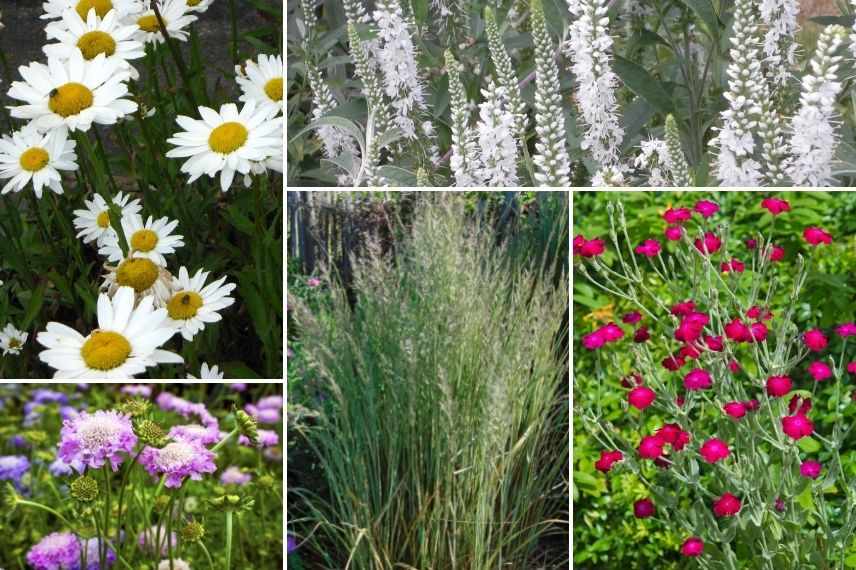
Leucanthemum superbum ‘Gruppenstolz’, Veronica spicata ‘Alba’, Scabiosa columbaria ‘Pink Mist’, Calamagrostis ‘Avalanche’ and Lychnis coronaria
Discover other Leucanthemum - Marguerite
View all →Available in 2 sizes
Available in 2 sizes
Available in 1 sizes
Available in 3 sizes
Available in 1 sizes
Available in 1 sizes
Available in 1 sizes
Available in 1 sizes
Available in 1 sizes
Available in 1 sizes
In a romantic garden
For this decor, opt for light and soft shades. Leucanthemum is a good companion for roses, creating romantic scenes together. We recommend the very chic variety Leucanthemum superbum ‘Christine Hagemann’, which features white flowers with a very double centre, or the elegant Leucanthemum superbum ‘Wirral Supreme’ with double frilled flowers. Both bear large flowers measuring between 6 and 10 cm in diameter. You can plant them alongside English roses such as David Austin ‘The Ancient Mariner’, ‘Gertrude Jekyll’, or ‘Strawberry Hill’, as well as peonies like Paeonia lactiflora ‘Lady Alexandra Duff’, ‘Gay Paree’, or Paeonia itoh ‘Hillary’.
On a support like an arch, a pergola, or a trellis, let a clematis climb such as Clematis ‘Maria Skłodowska Curie’ with double white flowers or Clematis montana ‘Freda’ with simple pink flowers. Phlox paniculatus, campanulas, and astrantias will provide shade for the clematis, which prefers to keep its roots cool. Accompany everything with a well-pruned bush honeysuckle. The Lonicera nitida ‘Tidy Tips’ is ideal for topiary, trimmed into rounded shapes: sculpted into balls if isolated or in waves in a low hedge.
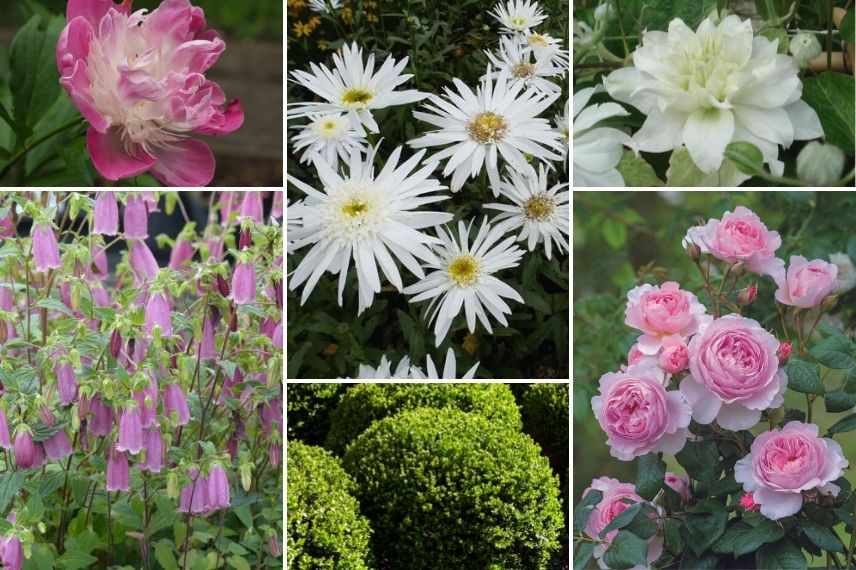
Paeonia lactiflora ‘Gay Paree’, Leucanthemum superbum ‘Christine Hagemann’ (photo Guido), Clematis ‘Maria Skłodowska Curie’, Campanula ‘Ringsabell Mulberry Rose’, Lonicera nitida, and Rose ‘The Ancient Mariner’
Read also
Pairing LeucanthemumsIn a white monochrome garden
The daisy is perfect for a monochrome white setting. In sunny or partially shaded locations, you can create an elegant scene by combining bushes and perennials. For this style of garden, you might choose Leucanthemum x superbum ‘Polaris’ with its classic flowers, Leucanthemum ‘Real Neat’ featuring channelled petals that give it originality, or Leucanthemum ‘Victorian Secret’ with its fluffy double flowers.
In the background, place the bushes. Buddleja davidii ‘Rêve de Papillon Blanc’ accompanies Hebe rakaiensis and Hibiscus syriacus ‘Eléonore’. Integrate alongside them perennials with erect spike-like flowers (Foxglove, Lupin, Physostegia or Eremurus), which contrast with the round inflorescences. Then, a Monarda ‘Schneewittchen’ pairs well with perennials featuring small pompom-like flowers that lighten the bed: for example, Anaphalis margaritacea ‘Neuschnee’ or Gypsophila paniculata ‘Bristol Fairy’. At the front, install perennials with silver foliage, such as wormwood or silver carpet with a spreading habit that will add a bright finish to the border of the bed.
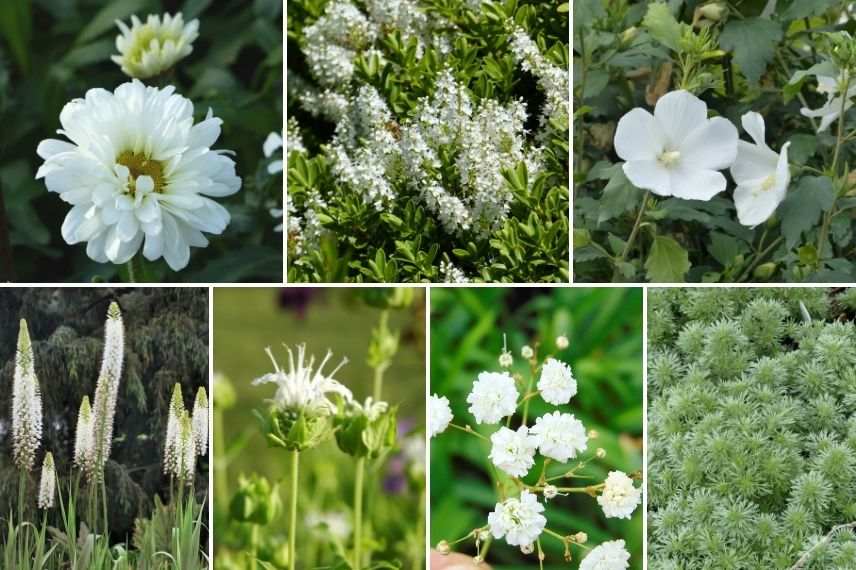
Leucanthemum ‘Victorian Secret’, Hebe rakaiensis, Hibiscus syriacus ‘Eleonore’, Eremurus himalaicus, Monarda ‘Schneewittchen’ (photo roddh), Gypsophila paniculata ‘Bristol Fairy’ and Artemisia schmidtiana ‘Nana’
In a large pot, a trough or a container
To decorate your terrace or balcony, the most compact varieties of leucanthemum are well-suited for container or large pot cultivation. For example, the highly floriferous Leucanthemum ‘Princesse d’Argent’ is a dwarf version of the large daisy, measuring 30 cm in all directions and displaying large white daisies of 7 cm. The Leucanthemum ‘Snow Lady’ is of the same size. Also modest in height, the Leucanthemum ‘Kings Crown’ with its frilled petals is slightly wider than it is tall. These varieties will look wonderful in a trough or a large zinc basin. To successfully create your display, pair the leucanthemum with a well-structured perennial in a bold colour, such as the spiked veronica ‘Bubblegum Candles’ in deep pink or ‘First Love’, alongside a plant with a soft hue, like the whorled coreopsis ‘Moonbeam’ with pale yellow flowering and a low-growing plant, such as Alyssum ‘Snow Crystals’ or Hutchinsia alpina with its creeping habit and small white bouquets. This alpine cress performs very well in pots, filling empty spaces.
Finally, to dress the container, you can add a trailing plant at the edge of your pot: Dichondra ‘Silver Falls’ (used as an annual) or Lysimachia nummularia ‘Goldilocks’. You can also choose to plant your leucanthemum solitary in its container and surround it with other flowering pots.
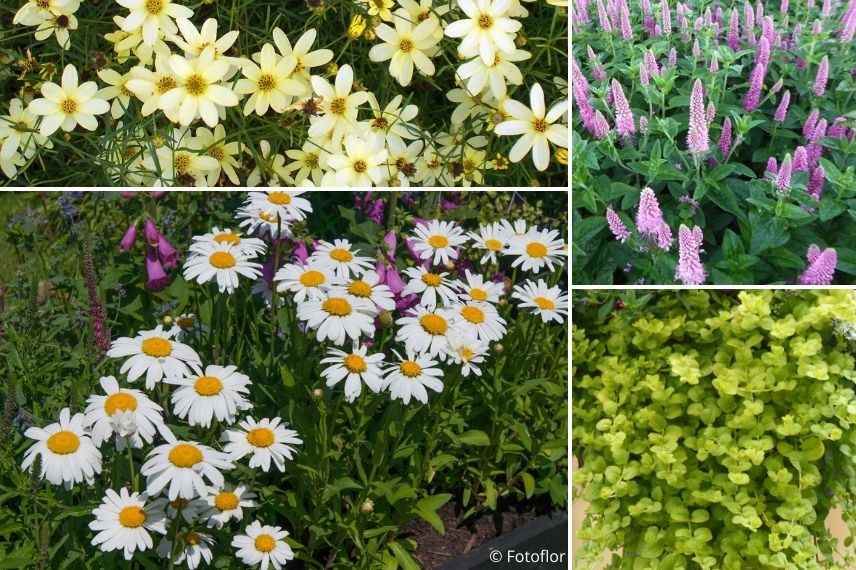
Coreopsis verticillata ‘Moonbeam’ (photo P. Standish), Veronica ‘First Love’ (photo Guido), Leucanthemum ‘Princesse d’Argent’ and Lysimachia nummularia ‘Goldilocks’
- Subscribe!
- Contents
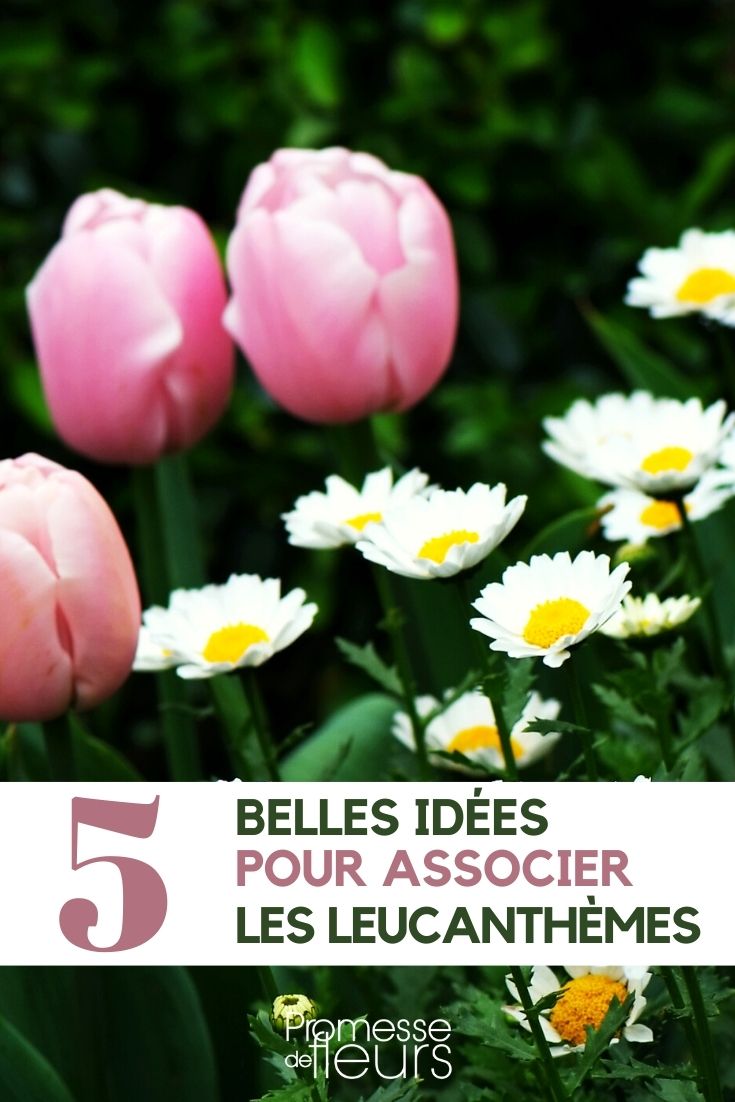

































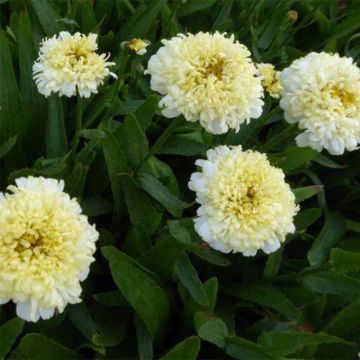

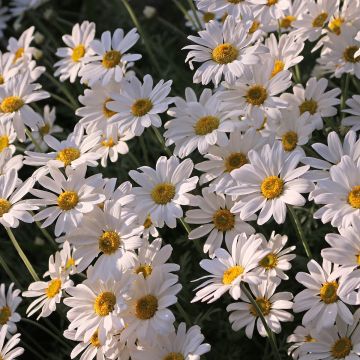



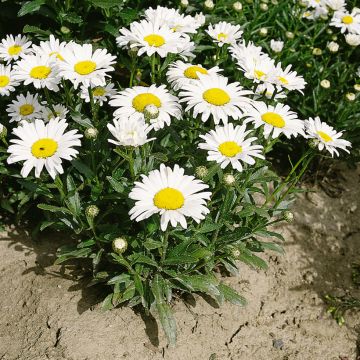

Comments